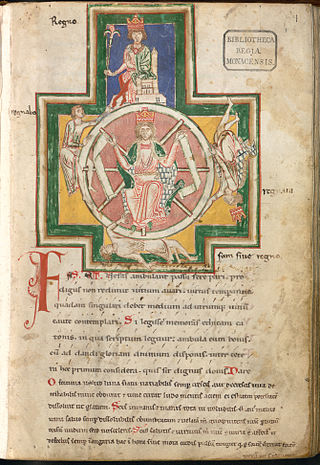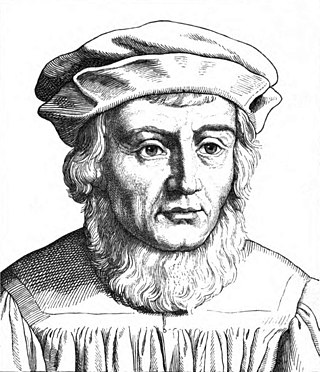
Carmina Burana is a manuscript of 254 poems and dramatic texts mostly from the 11th or 12th century, although some are from the 13th century. The pieces are mostly bawdy, irreverent, and satirical. They were written principally in Medieval Latin, a few in Middle High German and old Arpitan. Some are macaronic, a mixture of Latin and German or French vernacular.

Johann Georg Turmair, known by the pen name Johannes Aventinus or Aventin, was a Bavarian Renaissance humanist historian and philologist. He authored the 1523 Annals of Bavaria, a valuable record of the early history of Germany.
The Annales Sangallenses maiores are annals compiled in St Gallen, covering the years 927 through to 1059. They continue the Annales Alamannici, the St Gallen version of which reaches up to 926.
Otto of Nordheim was Duke of Bavaria from 1061 until 1070. He was one of the leaders of the Saxon revolt of 1073–1075 and the Saxon revolt of 1077–1088 against King Henry IV of Germany.
André Duchesne was a French geographer and historian, generally styled the father of French history.

The Royal Frankish Annals, also called the Annales Laurissenses maiores, are a series of annals composed in Latin in the Carolingian Francia, recording year-by-year the state of the monarchy from 741 to 829. Their authorship is unknown, though Wilhelm von Giesebrecht suggested that Arno of Salzburg was the author of an early section surviving in the copy at Lorsch Abbey. The Annals are believed to have been composed in successive sections by different authors, and then compiled.

Thietmar, Prince-Bishop of Merseburg from 1009 until his death in 1018, was an important chronicler recording the reigns of German kings and Holy Roman Emperors of the Ottonian (Saxon) dynasty. Two of Thietmar's great-grandfathers, both referred to as Liuthar, were the Saxon nobles Lothar II, Count of Stade, and Lothar I, Count of Walbeck. They were both killed fighting the Slavs at the Battle of Lenzen.

Benediktbeuern Abbey is an institute of the Salesians of Don Bosco, originally a monastery of the Benedictine Order, in Benediktbeuern in Bavaria, near the Kochelsee, 64 km south-south-west of Munich. It is the oldest and one of the most beautiful monasteries in Upper Bavaria. It was badly damaged in an extreme weather event in 2023.

The Battle of Pressburg, or Battle of Pozsony, or Battle of Bratislava was a three-day-long battle fought between 4 and 6 July 907, during which the East Francian army, consisting mainly of Bavarian troops led by Margrave Luitpold, was annihilated by Hungarian forces.
Hermann of Altach was a medieval historian. He received his education at the Benedictine monastery of Niederaltaich, where he afterwards made his vows and was appointed custodian of the church. In this capacity he became thoroughly acquainted with the records of the monastery. Under Abbot Ditmar (1232–42) he was sent on important missions concerning the interests of the monastery, first to the emperor in Verona, then to the Roman Curia in 1239 and again in 1240. On 27 October 1242, he was elected Abbot of Niederaltaich. During his abbacy of thirty-one years the monastic discipline and the finances of the monastery were reportedly greatly improved. On 12 March 1273, he resigned his office on account of ill-health and old age, and spent the remaining two years of his life in retirement at his monastery.

The Series or Catalogus ducum Bavariae is a Latin regnal list of the Duchy of Bavaria compiled between 1250 and 1273. It covers the succession to the duchy from a semi-legendary "Theodo I" in 514 to 1244, when Otto II Wittelsbach was duke.

The Annales laureshamenses, also called Annals of Lorsch (AL), are a set of Reichsannalen that cover the years from 703 to 803, with a brief prologue. The annals begin where the "Chronica minora" of the Anglo-Saxon historian Bede leaves off—in the fifth year of the Emperor Tiberios III—and may have originally been composed as a continuation of Bede. The annals for the years up to 785 were written at the Abbey of Lorsch, but are dependent on earlier sources. Those for the years from 785 onward form an independent source and provide especially important coverage of the imperial coronation of Charlemagne in 800. The Annales laureshamenses have been translated into English.

The Chronica sancti Pantaleonis, also called the Annales sancti Panthaleonis Coloniensis maximi, is a medieval Latin universal history written at the Benedictine monastery of Saint Pantaleon in Cologne. It was written in 1237 and covers the history of the world in a series of annals from Creation down to the year of composition. A continuation down to 1249 was added later. Up to the year 1199 it relies heavily on other sources; from 1200 it is an independent source.
The Annales Petaviani (AP) is one of the so-called "minor annals group", three related Reichsannalen, year-by-year histories of the Carolingian empire composed in Latin. They are named after the former owner of the manuscript, the French Jesuit Denis Pétau (1583–1652), whose name, in Latin, is Dionysius Petavius. The standard critical edition of the Annales is that of Georg Pertz in the Monumenta Germaniae Historica.

Conrad Grünenberg, also spelled Konrad, Grünemberg, Grünberg was a patrician from Constance in southern Germany, known as the author of three books, two armorials and a travelogue: the Österreichische Wappenchronik ; the Wappenbuch, containing some 2000 coats-of-arms, which he presented as a gift to Emperor Frederick III; and the illustrated description of his 1486 pilgrimage to Jerusalem.
The Battle of the Inn was fought in 913, when a Hungarian raiding army, at their return from plunder attacks against Bavaria, Swabia, and Northern Burgundy, faced the combined army of Arnulf, Duke of Bavaria, Counts Erchanger and Burchard of Swabia, and Lord Udalrich, who defeated them at Aschbach by the River Inn.
Creontius or Craentius, Germanized Crantz, was a Bavarian official and historian.
Annales breves Wormatienses is the conventional title for a set of anonymous Latin annals known from a single manuscript found in the monastery of Kirschgarten in Worms. They cover the years 1165–1295 and, to judge by their focus, were probably written in the archdiocese of Mainz and not in Worms. The manuscript, copied at Kirschgarten between 1496 and 1510, is now in Copenhagen, Arnamagnæan Manuscript Collection, AM 830 4°, where the Annales are found on folios 134r–139v. It was edited by G. H. Pertz for the Monumenta Germaniae Historica series.
The Annales Tiliani are an anonymous set of Latin annals from the Frankish kingdom, covering the years 708–807. They are considered minor annals.
The battle of the Ries of 13 May 841 was a major engagement of the Carolingian civil war of 840–843. King Louis the German surprised and routed the army of Count Adalbert of Metz on the banks of the river Wörnitz in the Ries. Adalbert, who had been charged by the emperor Lothar I with preventing Louis from breaking out of Bavaria, was killed in the fighting. The victory allowed Louis to join up with King Charles the Bald and defeat Lothar in the battle of Fontenoy-en-Puisaye in late June.










